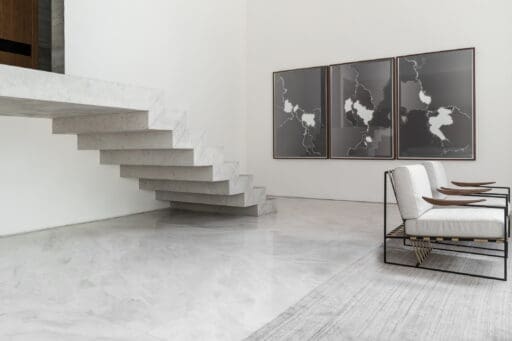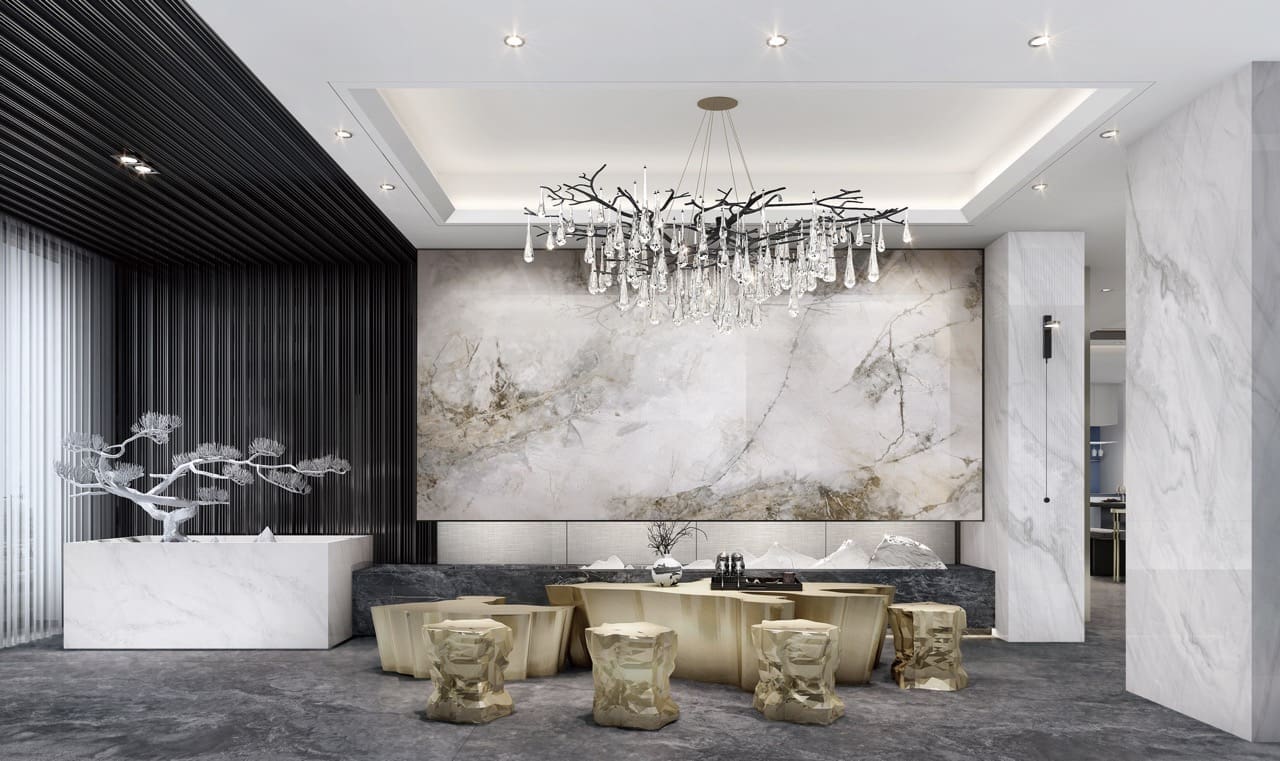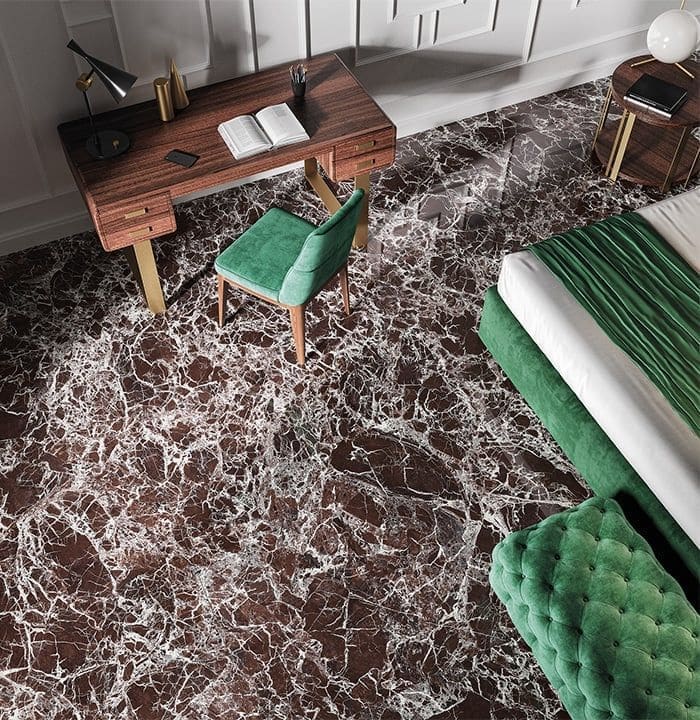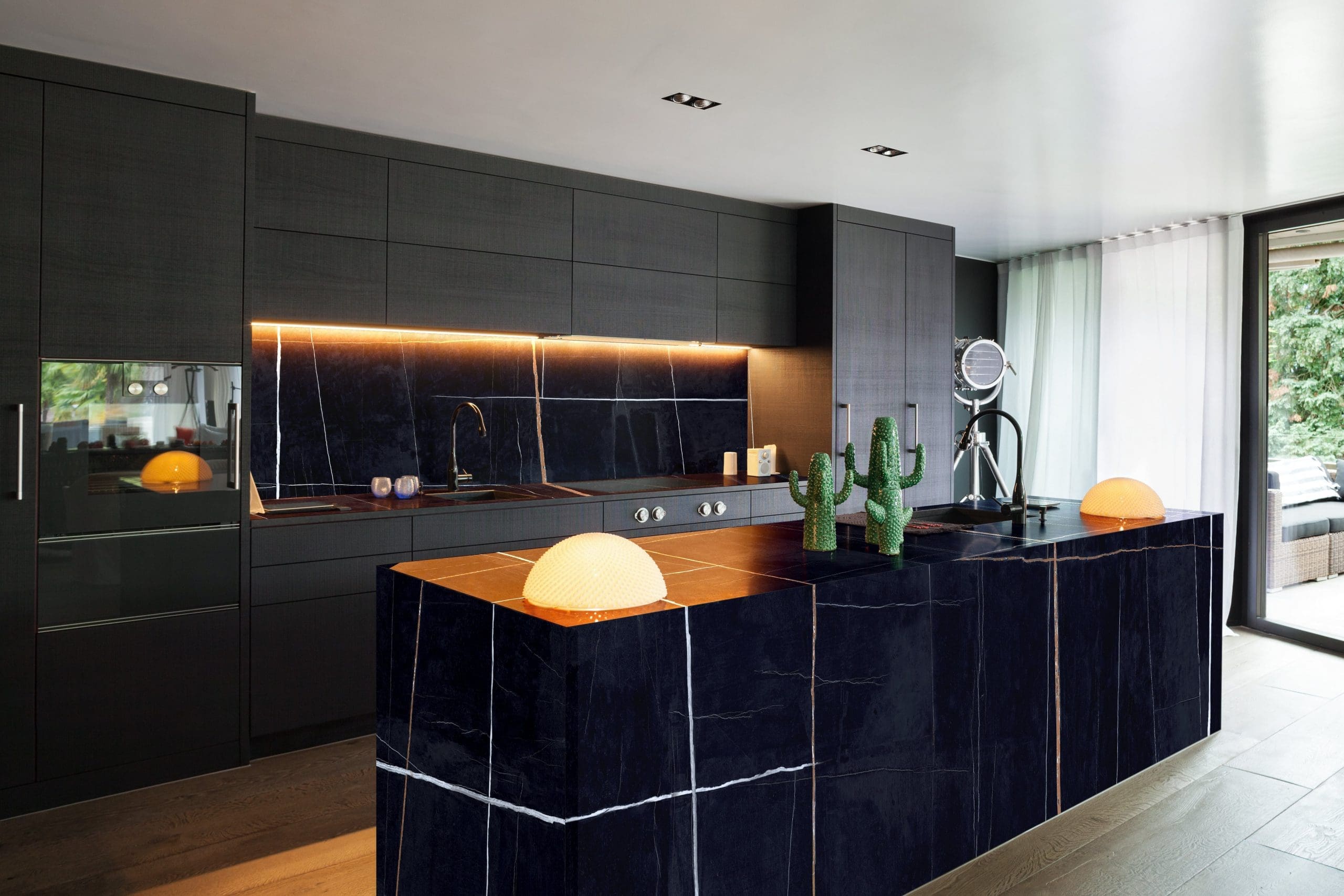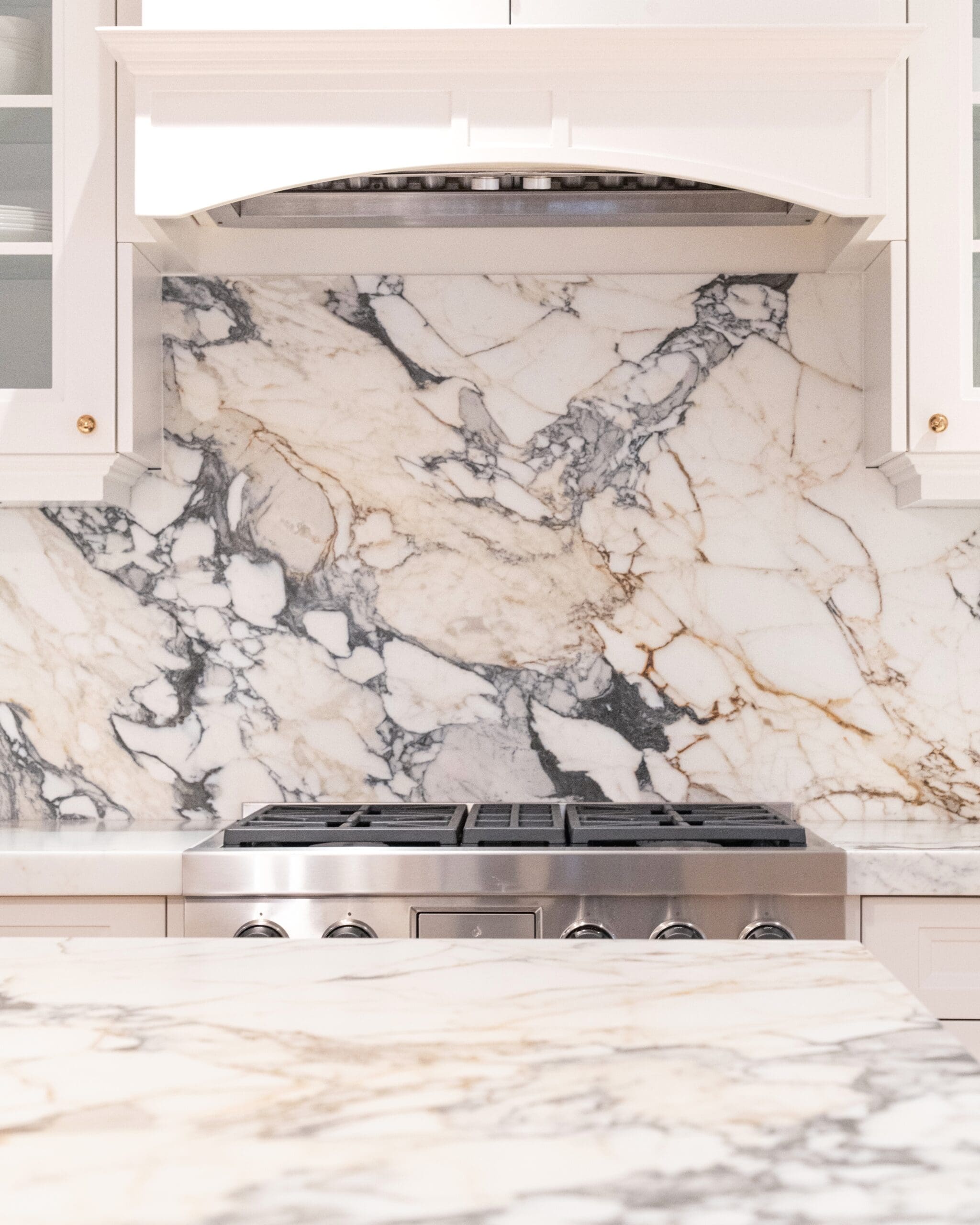Granite and marble are two of the most sought-after materials for premium stone surfaces, each offering unique benefits in terms of durability, appearance, and versatility. In this article, we’ll compare granite vs. marble to help you make the right choice for your home or commercial project. Whether you’re renovating a kitchen in the Greater Toronto Area or designing a luxury space, understanding the key differences in their properties, applications, and maintenance is essential. At Better Marble, a trusted stone supplier in the GTA, we offer expert advice and an extensive range of high-quality stone options to suit any design need.
Understanding Granite: Composition and Formation
What is Granite?
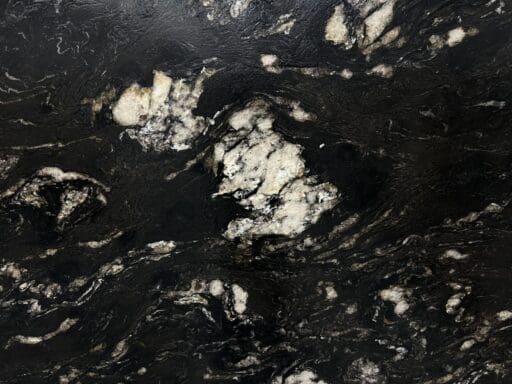
Granite is an igneous rock formed deep within the Earth’s crust under intense heat and pressure. This formation process results in a stone that’s incredibly hard and durable, composed primarily of quartz, feldspar, and mica. The varying proportions of these minerals create the diverse array of colours and patterns that make granite so visually appealing.
At Better Marble, we offer an impressive selection of granite varieties. Some of our most popular options include:
- Blue Dunes: A captivating blend of beige, blue, and grey tones with a dynamic wave pattern, perfect for adding a serene yet modern touch to any space
- Viscon White: A creamy granite with white and grey tones, featuring intricate swirls and veins. Perfect for adding elegance and visual interest.
- Titanium Gold 3cm: A striking black granite with swirling gold veins. Perfect for adding a touch of elegance and sophistication to any design.
- Tan Brown: A rich, earthy brown granite with black and gold flecks, ideal for warm, inviting spaces.
Key Properties of Granite
Granite’s geological origins endow it with some remarkable properties:
- Durability: Granite ranks 6-7 on the Mohs scale of hardness, making it highly resistant to scratches and chips. This exceptional granite vs marble durability is one of the main reasons it’s so popular for high-traffic areas.
- Heat Resistance: You can place hot pots directly on granite without fear of damage, making it an excellent choice for kitchen countertop materials.
- Low Porosity: While not completely non-porous, granite’s tight structure makes it naturally resistant to stains and bacteria, contributing to its ease of maintenance.
Popular Uses of Granite
Given its robust nature, granite finds numerous applications in both residential and commercial settings:
- Kitchen Countertops: The go-to choice for busy kitchens, granite countertops can withstand daily wear and tear while adding a touch of luxury.
- Bathroom Vanities: Granite’s water-resistant properties make it an excellent choice for bathroom surfaces, though it’s often reserved for high-traffic family bathrooms rather than luxury bathroom surfaces.
- Flooring: In high-traffic areas, granite flooring offers both durability and style, making it a popular choice for commercial spaces and grand entrances.
- Outdoor Applications: Granite’s weather-resistant properties make it suitable for outdoor kitchens or patio surfaces, extending the beauty of natural stone to exterior design.
Click here to browse our granite collection.
Understanding Marble: Composition and Formation
What is Marble?
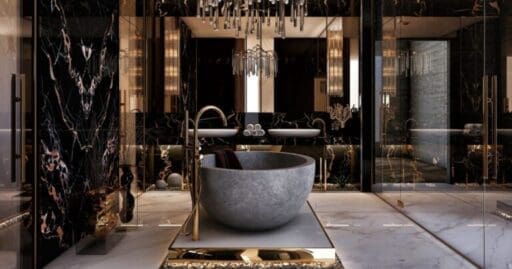
Marble is a metamorphic rock, formed when limestone is subjected to intense heat and pressure. This process results in distinctive veining patterns that are unique to each slab. This uniqueness is part of what makes marble so sought after for custom stone projects.
At Better Marble, we pride ourselves on offering some of the most sought-after marble varieties, including:
- Calacatta Picasso Gold: A prestigious Italian marble known for its bright white background and dramatic gold veining, often used in luxury bathroom surfaces.
- Statuario Extra Premium: Another Italian classic, featuring a clean white background with elegant gray veining, perfect for creating timeless interiors.
- Deep Roots: A rich mix of antique, brown, and gold tones, perfect for creating cozy and inviting interiors.
Key Properties of Marble
Marble’s unique formation gives it distinct characteristics:
- Softness: Compared to granite, marble is softer (3-5 on the Mohs scale), making it more susceptible to scratches and etching. This is a crucial factor to consider in the granite vs marble durability debate.
- Heat Sensitivity: Sudden temperature changes can cause marble to crack or discolour, making it less ideal for kitchen countertop materials.
- High Porosity: Marble is more porous than granite, requiring more frequent sealing to prevent staining.
Popular Uses of Marble
Despite its relative softness, marble’s unparalleled beauty makes it a favorite for various applications:
- Luxury Bathroom Surfaces: Marble vanities and shower walls create a spa-like atmosphere, turning ordinary bathrooms into luxurious retreats.
- Fireplace Surrounds: A marble fireplace becomes an instant focal point in any room, adding a touch of elegance and sophistication.
- Decorative Elements: From sculptures to accent walls, marble adds a touch of elegance to any space, making it a favorite for interior design with natural stone.
Click here to view our extensive marble collection.
Granite vs Marble: A Detailed Look
Appearance and Aesthetics
- Granite: Features a speckled or flecked appearance, with colours ranging from subtle whites and grays to bold reds and blues. This variety makes granite suitable for a wide range of design styles.
- Marble: Known for its smooth, veined appearance, with colours typically in softer hues of white, gray, and beige. The distinctive veining of marble is often what draws designers to this stone for luxury projects.
The choice between granite and marble often comes down to the overall design aesthetic you’re aiming for. Granite tends to complement more modern or rustic designs, while marble is often associated with classical and luxurious interiors. Both stones can be incorporated into contemporary designs, as evidenced by current stone design trends.
Durability and Maintenance
When it comes to long-term performance, the granite vs marble durability comparison often favors granite:
- Granite: Highly resistant to scratches, chips, and stains. Requires sealing every 1-2 years.
- Marble: More prone to scratching and etching, especially from acidic substances. Needs sealing every 6-12 months.
For busy kitchens or high-traffic areas, granite’s durability makes it a more practical choice. However, with proper care and maintenance, marble can also stand the test of time, particularly in less demanding environments like bathrooms or low-traffic areas.
Cost Considerations
Initial costs can vary widely depending on the specific variety and quality of the stone:
- Granite: Generally ranges from $40 to $100 per square foot installed.
- Marble: Typically ranges from $50 to $150 per square foot installed.
While marble often comes with a higher price tag, both stones should be viewed as long-term investments that can significantly increase your property’s value. The expertise required for proper installation also contributes to the cost, which is why working with experienced stone fabrication experts is crucial.
Environmental Impact
Granite and marble are natural stones with environmental considerations. Modern quarrying practices and local sourcing can minimize impacts. Their longevity and durability reduces the need for frequent replacements, making them more eco-friendly. At Better Marble, we prioritize sustainability and can help you choose eco-friendly options.
Choosing the Right Stone for Specific Applications
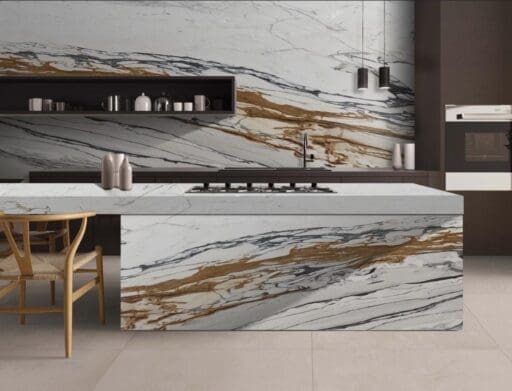
Kitchen Surfaces
For kitchens, granite often emerges as the preferred choice among kitchen countertop materials:
- Pros of Granite: Extremely durable, heat-resistant, and low-maintenance. Its ability to withstand the rigors of daily cooking and cleaning makes it ideal for busy kitchens.
- Cons of Marble: More susceptible to etching from acidic foods and staining. While beautiful, marble requires more careful use and immediate cleaning of spills in kitchen environments.
However, for those willing to embrace some patina over time, marble can create a truly unique and lived-in kitchen aesthetic. Some homeowners appreciate the way marble ages, developing a character that tells the story of the home.
Bathroom Surfaces
In bathrooms, both stones have their merits:
- Granite: Excellent for high-traffic family bathrooms due to its durability and ease of cleaning. It’s particularly suitable for children’s bathrooms or guest bathrooms that see frequent use.
- Marble: Perfect for creating luxury bathroom surfaces, especially in master bathrooms. The cool, smooth feel of marble and its elegant appearance can transform an ordinary bathroom into a spa-like retreat.
Consider the specific needs of each bathroom in your home or project when making your selection. A master ensuite might benefit from the luxury of marble, while a family bathroom might be better suited to the practicality of granite.
Flooring
For flooring applications, the granite vs marble durability factor plays a significant role:
- Granite: Ideal for high-traffic areas due to its hardness and slip-resistance when given a flamed or brushed finish. It’s an excellent choice for entryways, hallways, and commercial spaces.
- Marble: Can create a stunning visual impact but requires more maintenance and care, especially in entryways or other high-traffic zones. Marble flooring is often reserved for formal areas or spaces where its luxury appearance outweighs maintenance concerns.
Check out our application gallery to see these stones in action and get inspired!
Installation and Fabrication: The Role of Stone Fabrication Experts

Proper installation is crucial for both granite and marble to ensure longevity and optimal appearance. This is where the expertise of stone fabrication experts becomes invaluable.
Granite Installation Process
- Requires specialized cutting tools due to its hardness.
- Seams can be nearly invisible when properly done.
- Large slabs allow for fewer seams in expansive areas.
The granite installation process typically involves:
- Template creation
- Fabrication of the stone according to the template
- Transportation of the cut stone to the installation site
- Careful placement and securing of the stone
- Sealing the stone to protect against stains
Marble Installation
- Requires careful handling to prevent chipping or cracking.
- Offers beautiful options for bookmatching, where slabs are cut and arranged to create mirror-image patterns.
- May require more support underneath due to its relative softness compared to granite.
The marble installation process is similar to granite but with some key differences:
- More careful handling during transportation and installation
- Potentially more complex cutting for intricate designs or bookmatching
- Additional care in sealing due to marble’s higher porosity
Maintenance and Care
Proper care is essential for maintaining the beauty of your stone surfaces. Following a comprehensive marble care guide or granite maintenance plan can significantly extend the life and beauty of your stone.
Caring for Granite
- 1. Clean daily with a mild soap and water solution.
- Avoid harsh or acidic cleaners that can damage the sealant.
- Seal every 1-2 years, or as needed based on use.
- Use cutting boards and trivets to prevent potential scratches or heat damage.
- Wipe up spills promptly to prevent potential staining.
Caring for Marble
- Wipe spills immediately, especially acidic substances like wine, citrus juices, or vinegar.
- Use a pH-neutral cleaner specifically designed for marble.
- Seal every 6-12 months to maintain stain resistance.
- Consider professional polishing every few years to restore shine.
- Use coasters under glasses and place mats under dishes to prevent etching.
By following these stone maintenance tips, you can ensure that your granite or marble surfaces remain beautiful for years to come.
Comparing Granite vs Quartz vs Marble
| Aspect | Granite | Quartz | Marble |
| Composition | Natural igneous rock | Engineered stone (93% quartz + 7% resin) | Natural metamorphic rock |
| Appearance | Speckled or mottled patterns | Uniform or custom-designed patterns | Distinctive veining patterns |
| Colour Range | Wide range of natural colours | Vast range of colours, including those not found in nature | Limited range of natural colours |
| Durability | Very durable (6-7 on Mohs scale) | Extremely durable (7 on Mohs scale) | Less durable (3-5 on Mohs scale) |
| Heat Resistance | Excellent | Good (but can discolour from extreme heat) | Poor (can scorch or discolour) |
| Scratch Resistance | High | Very high | Low |
| Stain Resistance | Good (when sealed) | Excellent (non-porous) | Poor (highly porous) |
| Maintenance | Low (period sealing required) | Very low (no sealing needed) | High (frequent sealing and careful cleaning) |
| Cost | Moderate to high | High | High to very high |
| Eco-Friendliness | Natural product, but quarrying has environmental impact | Engineered product with some environmental concerns | Natural product, but quarrying has environmental impact |
| Best Uses | Kitchens, bathrooms, high-traffic areas | Kitchens, bathrooms, commercial spaces | Luxury bathrooms, low-traffic areas, decorative elements |
| Installation | Requires professional installation | Requires professional installation | Requires professional installation |
| Resale Value | Generally increases home value | Generally increases home value | Can significantly increase home value |
Design Trends and Inspiration 2024
Current Trends in Granite Design
- Bold, Dramatic Patterns: Stones like Titanium or Viscon White are making statement pieces in kitchens and bathrooms.
- Leathered Finishes: This textured finish is gaining popularity for its unique look and feel, providing a middle ground between polished and honed surfaces.
- Mixed Materials: Pairing granite with wood or metallic accents creates visually interesting spaces, adding depth and character to interiors.
- Waterfall Edges: Continuing the countertop material down the sides of islands or cabinets creates a sleek, modern look.
Marble in Contemporary Design
- Large Format Slabs: Using large marble slabs for feature walls or shower enclosures creates a seamless, luxurious look.
- Coloured Marble: While white marbles like Calacatta remain popular, we’re seeing increased interest in coloured marbles like Eldorado Blue.
- Book-matched Patterns: Creating symmetrical patterns with matched marble slabs is a growing trend in high-end design, particularly in luxury bathroom surfaces.
- Thin Porcelain Slabs: While not traditional marble, these marble-look surfaces are gaining popularity for their lightweight nature and large format options.
Visit our showroom to experience our wide range of granite and marble options in person. See and feel the textures, compare colours, and visualize how different stones might look in your space.
Practical Considerations Before You Choose: Expert Insights and Tips
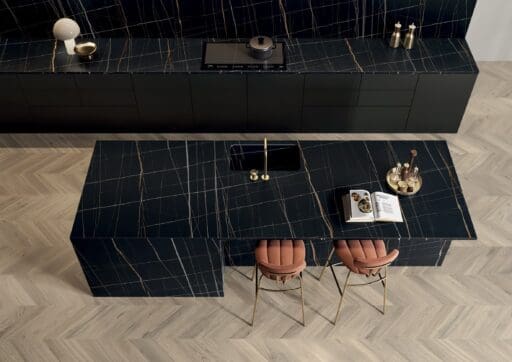
When choosing between granite and marble, consider these expert tips from stone fabrication experts:
- Think Long-term: Consider not just your immediate needs, but how your space will be used over time. Will the durability of granite be crucial, or is the classic elegance of marble more important for your project?
- Sample in Your Space: View samples of high-quality stone products in your actual space under different lighting conditions before making a final decision. How it looks in a showroom might appear different in your home’s lighting.
- Consider Maintenance: Be honest about how much maintenance you’re willing to commit to. If you’re not prepared for the upkeep that marble requires, granite might be a better choice.
- Balance Aesthetics and Practicality: While the beauty of a stone is important, also consider its practical implications. A heavily veined marble might be stunning but could make it difficult to read text on the surface if used as a desk or workspace.
- Think About the Whole Space: Consider how your chosen stone will interact with other elements in the room. Will it complement or clash with existing materials and colours?
- Don’t Forget the Details: Pay attention to edge profiles, finishes, and other details that can significantly impact the overall look of your stone installation.
- Consult Professionals: Work with experienced designers and Greater Toronto Area stone suppliers who can guide you through the selection and installation process. Their expertise can help you avoid common pitfalls and achieve the best possible outcome.
Still undecided? Call us to speak to our team of stone experts. They can guide you through the selection process, answer your questions, and help you choose the perfect stone for your space.
Conclusion: Making Your Stone Selection
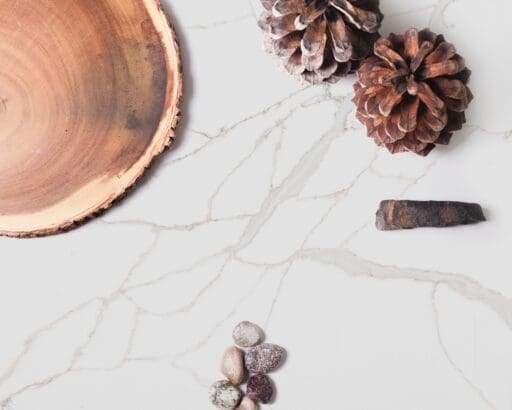
Choosing between granite and marble is more than just a matter of aesthetics; it’s about finding the right material that aligns with your lifestyle, maintenance preferences, and design vision. Both stones offer unique benefits:
- Granite excels in durability and low maintenance, making it ideal for busy kitchens and high-traffic areas. Its resistance to heat, scratches, and stains makes it a practical choice for active households or commercial spaces.
- Marble offers unparalleled elegance and a classic look that can elevate any space, particularly in more formal or low-traffic areas. Its unique veining patterns and lustrous appearance make it a favorite for luxury bathroom surfaces and statement pieces.
Ultimately, the choice between granite and marble comes down to your specific needs, aesthetic preferences, and how you plan to use the space. Consider factors such as:
- The level of use and traffic in the area
- Your willingness to perform regular maintenance
- The overall design aesthetic of your space
- Your budget for both initial installation and long-term care
- The potential impact on your property value
Remember, both granite and marble are premium stone surfaces that can add significant value and beauty to your home or commercial space. The key is to make an informed decision based on a thorough understanding of each stone’s properties and your specific requirements.
Call us at (416) 667-1515 or visit our showroom at 300 Norfinch Dr. to start your journey with natural stone. Let’s create something beautiful together!
FAQ
How often should I seal granite and marble?
- Granite: Seal every 1-2 years to maintain stain resistance.
- Marble: Seal every 6-12 months due to higher porosity and susceptibility to staining.
Can marble be used in a busy kitchen?
- Yes, but it requires more care. Marble can stain and scratch more easily, so spills should be cleaned immediately, and regular maintenance is necessary.
Which is more heat-resistant: granite or marble?
- Granite is more heat-resistant and can handle hot cookware. Marble is more sensitive to heat and can crack, so always use trivets.
Which is more budget-friendly?
- Granite typically ranges from $40 to $100 per square foot, while marble is pricier, ranging from $50 to $150 per square foot.
Can granite and marble be used outdoors?
- Granite is ideal for outdoor use due to its weather resistance. Marble is better suited for indoor applications as it can weather over time outdoors.
How do I clean and maintain granite and marble?
- Granite: Clean with mild soap and water; seal every 1-2 years.
- Marble: Use pH-neutral cleaners and seal every 6-12 months. Wipe spills immediately to prevent stains.
How do I choose between granite and marble?
- Choose granite for durability and low maintenance in high-traffic areas. Opt for marble for elegance in low-traffic spaces like bathrooms.
Does using granite or marble increase property value?
- Yes, both stones are premium materials that can boost home value, with granite known for durability and marble for its luxury appeal.
Is marble harder to install than granite?
- Marble is more delicate and requires careful handling during installation. Granite is tougher and easier to install but still requires professional expertise.
How can I keep my granite or marble looking great?
- Regular cleaning, sealing, and occasional professional polishing will help maintain their beauty over time.


